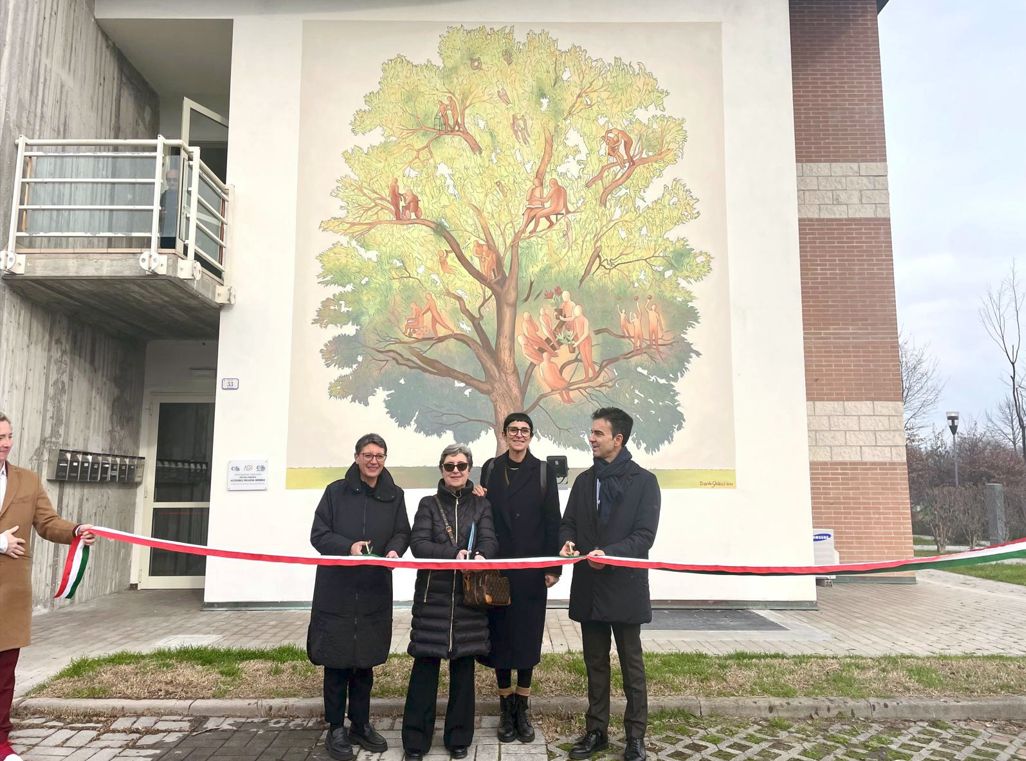REGGIO EMILIA (ITALPRESS) – Barriers to the inclusiveness of the elderly and frail are not only physical ones, but they are mainly social and cultural ones. All of them, can be broken down. It should be written on all walls, with the universal language of art, for it to be memory for citizens. This is the goal of ‘A mural for health, #unmuraleperlasalute, created by Reggio Emilia artist Davide Ghiacci, promoted by the National Federation of TSRM and PSTRP Orders, which represents 18 health professions in the technical, rehabilitation and prevention area, and the ASP Reggio Emilia – City of People, which operates in Reggio Emilia in the organization and delivery of social welfare and social-health services for elderly people in a state of physical and/or mental non-self-sufficiency, disabled adults, and is also involved in the management of services for minors, also raising awareness of the daily difficulties of the elderly, the importance of an inclusive environment, and fostering the creation of a link between the health professions and the local community.The mural, created thanks to the local coordination of the TSRM and PSTRP Order of Modena and Reggio Emilia, was unveiled Jan. 11 on a facade of Villa Le Mimose at 33 Via Guinizelli in Reggio Emilia. It is a symbol-rich painting meant to evoke how each of us has the right to be valued, and that care, prevention and inclusion are to be fostered through the synergistic work of all health professionals, caregivers, and the community at large. Themes also expressed in Law 33/2023, which gives delegated powers to the government on policies in favor of the elderly.’The one in Reggio Emilia is the second mural we are making, the first we inaugurated in Veneto, in Chioggia. But there will be others, because we want to continue to make citizens aware of how much the professionals belonging to our Orders are able to promote the wellbeing of the person with physical, psychic or social difficultiesè, premits Teresa Calandra, president of the National Federation of TSRM and PSTRP Orders. ‘Citizens still do not know all the health professions that our institution represents. Instead, they deserve a different notoriety. This mural is a reminder that we can only make a difference on the issue of inclusiveness if we work together, united in the same directionè. The mural represents many people, without a uniform, who are picking a fruit. They are the health care professionals, working together with caregivers every day to promote the well-being and health of the person, as well as inclusiveness in society. ‘For us, this mural is a symbol, and we want all citizens to know more and more about the work that we health professionals do in a synergistic way with colleagues and families of the elderly and frail. Health care workers belonging to our Order are present in hospitals, community facilities or even in the homes of people in need. They deal with diagnostics, rehabilitation, management of behavioral strategies aimed at self-sufficiency, they work on prevention and everything that can help integration in the community,’ echoes Massimiliano Contesini, president of the TSRM and PSTRP Order of Modena and Reggio Emilia. And, continues Mariella Martini, president of the ASP Reggio Emilia – City of People, which has made available the wall of Villa Le Mimose on which ‘A Mural for Health’ is painted, ‘All these health professions, for us, are very important. Every day they do an egregious job within our facilities for the elderly and disabled. We very enthusiastically welcomed the initiative ‘A mural for salutè, because it highlights and values the skills and role that these professionals play and exercise every day. Moreover, ‘this mural will be able to be seen by the whole community, because it is in a strategic place in the city. I am convinced that it will be both a testimony to how beauty can raise awareness, but it will also be a practical contribution, inviting solidarity. Fostering inclusiveness is a commitment we should all make, starting by breaking down social wallsì.What barriers do we have to deal with every day? ‘Especially for the older person, they are of three types: physical, social and psychological. Three typical barriers that are created when a person begins to lose his or her autonomy, and there begins to be a lack of physical strength, balance or coordination problems, explains Gianluca Valestri, physiotherapist at Villa Le Mimose: ‘Our intervention is rehabilitative, cooperating with other health professions, we deal with the recovery of strength, coordination and balance. And this gives more security to the personà.These interventions are fundamental for the well-being of the person, but if the social part is not solid you will face prejudice, intolerance, and exclusion. This is why, stresses Vanda Menon, head of the Center for Cognitive Disorders and Dementia in Carpi, Ausl of Modena, we need to work on prevention. ‘Dementia causes one to lose not only the ability to remember, and think of what it can mean for a child, relative or friend not to be recognized by their loved one, but also so much more. Those who, like me, deal with these issues, in addition to the therapies available today, should be concerned with facilitating a link with the area in which these people live. And to do so, adds the expert who has edited several manuals on the subject and has done a TEDx on the topic, ‘we need to avoid isolation, which is among the risk factors for dementia, and which over time can lead to a depletion of cognitive abilities far greater than they would be in a reality where the word inclusion, solidarity and kindness are really put into practiceà.But how do you make sure they are really put into practice? ‘Training and participation are two key words,’ Menon continued: ‘We have organized training courses for pharmacists, who are among the points of reference for citizens, and together with the Family Associations we organize moments of inclusivity, such as walks, or moments of meeting where tools such as art or other activities are used that can make everyone feel free to express themselves, without barriers pinned down. Tools also indicated in Law 33/2023. But they are not enough: we need to raise everyone’s awareness to work on prevention. ‘And it must start as early as in the womb. Today the 14 risk factors for dementia are known and they are: smoking, the presence of bad cholesterol already at a young age, impaired vision health, low level of education, hearing loss, hypertension, alcohol abuse, obesity, depression, physical inactivity, diabetes, head injury, pollution and social isolation. All these factors are known and published in scientific studies, knowing about them and working on education and awareness of people, much can be done to prevent dementia numbers from increasing, Vanda Menon adds.The sociality of elderly and frail people is an important aspect, but education should be done to citizens: ‘That people with cognitive disorders stay among others, socialize, and can have a stimulating life is a factor that we should incentivize, with educational actions to the whole citizenship, remarks Morena Pellati, District Director and Director of S.C. Program Elderly and Frailty of the AUSL of Reggio Emilia. And again, these acts are also mentioned in Law 33/2023, where in Chapter II, Article 3 paragraph 2 reads ‘promotion of programs and integrated pathways aimed at counteracting isolation, marginalization, social and civil exclusion, relational and affective deprivation of the elderlyè. ‘We will have to work on the concept of residency and territoriality in a broad and concrete way, providing actions aimed at the integration and inclusion of elderly and frail people. We are working on this, Pellati let us know.Law 33/2023 also highlights how important multidisciplinarity among experts is: ‘It is fundamental that the citizenry understands the importance of the work done by us health professionals. Together with family members, citizens, and the entire community we must take concrete actions to support the most fragile and distressed people. Each of us can be an active part of the inclusion process, even with small changes in action. We need to break down the wall of indifference and open the doors to helpfulness, truly becoming part of an aging community that brings value at every stage of life. ‘We have symbolically chosen a wall, on which a painting has been made, as a present and future memory for citizens, precisely to emphasize these two fundamental aspects,’ says Margherita Schiavi, occupational therapist and member of the TSRM PSTRP Order.’Since I have encountered disability and frailty, I can’t help but also think of terms such as beauty, depth, respect and sense,’ says Annalisa Rabitti, Councillor for Care of People, with delegated powers for social policies, Family Support, Housing Policies, City without Barriers, Equal Opportunities. ‘Beauty, in the broadest sense that this concept allows us to imagine, in the lives of frail people is a powerful means of innovation. The encounter between frailty and art is generative of new opportunities and social inclusion. all this has a very deep meaning. I believe that beauty should be a right: we will have to work on the prejudice that still resides in those who believe that beauty is superfluous, it is not. When we think and work on inclusion, we should not do it one way, because fragile we all are. Meeting everyone’s fragility and telling about it makes us stronger. My idea is to bring fragile people to the center and not keep them on the margins of planning. Initiatives like these are therefore very important, because they help us open places: they are good for us and for the world. And they should be valued, not only on the day of the inauguration,´ concluded the Councillor.Supporting the event were the Minister of Health, Orazio Schillaci, the Minister for Disability, Alessandra Locatelli, singer Orietta Berti, with a video greeting, and the historic Reggio Emilia band L’Officina del Battagliero, which entertained guests after the ribbon-cutting ceremony in front of the mural.Present at the inauguration event ‘A Mural for Salutè were artist Davide Ghiacci, who emphasized how much the universal language of art can be a vehicle to reach everyone, without limits; Liliana Cosi, former La Scala ètoile and artistic director; and Simone Burzacchi, athlete of the Italian Men’s National Sitting Volleyball Team. Three health workers who participated in the social competition ‘A Mural for Health. Inclusion Possibleè, to raise awareness of the inclusion of frail people. The results can be seen on the IG page tsrm_pstrp_more.-photo press office FNO TSRM and PSTRP – (ITALPRESS).

